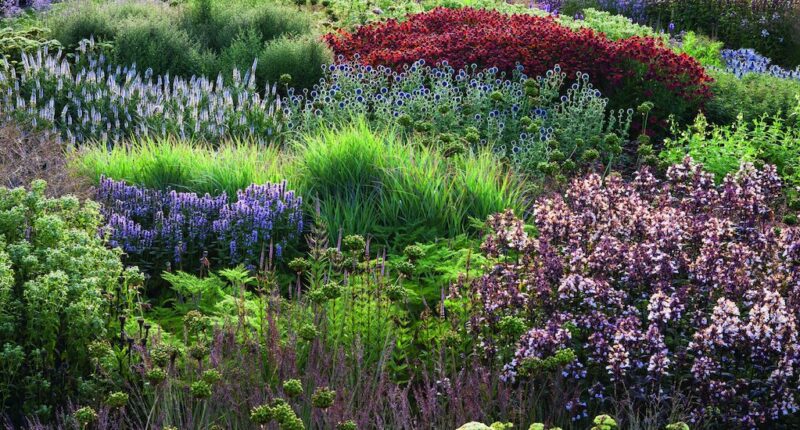
There is a transcendent quality to the gardens of the Dutch designer Piet Oudolf, which overtake us with the sense that we have arrived at a place where we would like — and very much need — to spend more time. Drawn into the complex textural mosaic of muted colors, we can exhale.
Even when his landscapes sit against the backdrop of an urban setting, as many of his best-known works do — the High Line in New York City, for example, or the Lurie Garden at Millennium Park in Chicago — we feel ourselves enveloped in nature, our craving for it fed.
And yet, Mr. Oudolf is quick to point out, his work is the art and craft of garden making. It is not ecological landscape restoration. His medium is naturalistic, yes, but it is not nature.
Nature impresses upon us “the greatest feelings,” he said in a recent conversation. “And I think that’s what you want to do in a garden as well.”
He added: “But the garden is smaller, and so you have to do something more than just this big idea of what nature is. You have to feel more than just what you see. It has to go a little bit deeper, and sometimes it’s called enhanced nature. And so you bring nature up a little bit, pump it up a little bit.”
Mr. Oudolf, 78, is the subject of the recently published Phaidon book “Piet Oudolf at Work,” a massive combination of testimonies to his influence by other designers, complemented by photographs and profiles of his gardens, as well as his own design drawings.
The sketches behind his landscapes are abstract art forms in their own right.
“I’m not a painter, but I can see things in my mind that I can translate into the ground,” he says in the book. “I can see things that will happen over time.”
What happens is that things will fade at the coming of frost (although that decay is anticipated and celebrated in the worlds he creates).
What happens is that things shift in balance as the plantings mature.
What happens is that some elements disappear, and the garden and the original planting plan no longer match exactly.
What happens is that the human hand of a skilled gardener must be there to evaluate, and adjust, as the landscape evolves.
What happens is an Oudolf garden.
Recently, I asked Mr. Oudolf to talk about his process and translate some of his insights into advice for home gardeners. (This interview has been edited for length and clarity.)
You came to gardening more than 50 years ago, and have said that it was English gardens that initially attracted you.
We traveled a lot to England with my family before I even started in the business for myself, places like Great Dixter, Beth Chatto’s, Sissinghurst — all these gardens. I was really impressed by them because of not only the craftsmanship, but also the plants. And I just fell for the plants and, of course, how they were put together.
You loved what you refer to in the book as the gardens’ “over-the-top quality,” but you also say, “English gardening is a lot about decoration and about doing the right thing at the right time.”
At that time, when you read English garden books, it was all about what to do and when to do it. It’s a bit dogmatic, telling people what to do in a garden. I felt that, without losing my interest in English gardens, I wanted to free myself a little bit from that idea that you had to do things in gardens at a particular time — a particular week or a particular day. Along with the needed craftsmanship, I wanted to do something creatively, without being restricted by rules.
Your landscapes are far looser than the classic English mixed borders within wall-like hedges, but they’re hardly chaotic. Are there foundational design principles that you would urge us all to consider?
A garden should be interesting all year long. And to make that happen, you need plants that are interesting over the seasons, even for late winter, early winter — and not necessarily by their flowers. It could be by structure, by leaf texture, even by how they look sprouting out of the ground — all the new things coming up and the leaves that come out, the buds. That’s for me important, too.
The second important thing is to think about wildlife, to contribute to wildlife — to choose plants that are also interesting for whatever insects and other little animals contribute to the beauty of your garden.
You find beauty in dried seed heads and other skeletal plant parts, and have said that you came to see decay as part of gardening. Do you have some favorite faded beauties?
Oh, many, many, many. Veronicastrum, for example. And Umbellifers — they have these beautiful seed heads. Or Joe Pye weed. These all have this strong character, even in the winter.
And some plants have a very dark brown color that is a very nice contrast to yellowed grasses that are performing through the winter. So the gardens then can be completely different because of everything that changes into another state of color.
You mentioned grasses, which are an important part of your palette.
Wild gardening is something I couldn’t do in my work, because wild gardening meant that you planted something and it lives its own life. So I learned from nature and from wilder areas, and was able to translate this into plant combinations that make a garden look a little bit wilder, more spontaneous. That’s why I started to use grasses, so that it became all looser and more blended, instead of just so solid.
You use many American native plants, but not just in American gardens.
If I was an ecologist working in a landscape, I would never use a nonnative, because it doesn’t belong. But we make gardens; we don’t make nature. We make gardens, and in gardens I think I’m allowed to use plants that I like.
And the good thing is I use plants that benefit the communities that I create.
If you use only North American plants, except for the woodland ones they mostly perform in late summer. If I mix them with some earlier ones from Europe, Eastern Europe — the sages and so on — then you can complete your garden.
If a plant doesn’t do any harm — and it benefits, because it flowers in the right season and it contributes to the garden — I don’t see a problem.
I would never use a nonnative in restoration. That is the big difference. And I don’t use invasive natives.
In the book you say, “I put plants on a stage and let them perform.” But the most difficult (and exciting) part is that we’re dealing with a cast of living plants — and even if we get things “right,” they don’t stay put. Do you have some guidance?
You think very clearly how the one plant will connect to the other — how it will play together as a community, or as an individual in that whole scene you create. You have to think of what it will do next year and the year after; things will change.
So we try to not put plants together that outcompete each other. The plants have to be not invasive, and not too competitive toward their neighbors, and also not short-lived.
But even if you do that, gardens change over the years, and it is necessary to have a good eye to look at that, and take action when necessary.
I wouldn’t say that you bring it back to what it originally was. One plant can disappear, but it doesn’t matter, because there’s so much happening already that you think, “Oh, it looks good, so leave it.”
It also has to do with management stewardship: If we don’t have the right people that take care of the garden, your garden will disappear in a few years’ time.
You write that if you don’t control the planting, you won’t like the results. What control tactics do you use that also foster the spirit of wildness?
Cover your ground with plants that grow together; don’t create too much bare ground. In time, your soil should be filled in with plants, and when they become mature, it takes less maintenance.
But still, it takes maintenance in the sense that you have to watch it all the time, otherwise it goes wrong. The control is more that you watch for what can go wrong.
Control is having the right people in place, having the right eye, being knowledgeable about plants and what they can do.
You need to have a gardener’s eye to notice what goes wrong. You need to know a lot to become a gardener. And you can do it your whole life, and you still don’t know everything.
Margaret Roach is the creator of the website and podcast A Way to Garden, and a book of the same name.
For weekly email updates on residential real estate news, sign up here.
Source: | This article originally belongs to Nytimes.com









